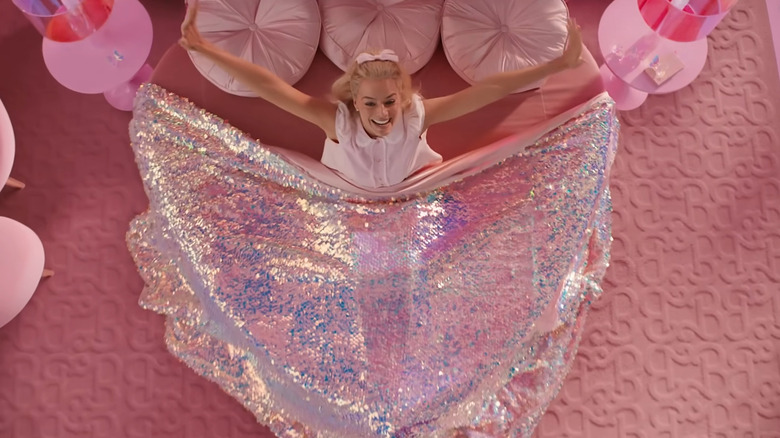Creating An Authentic Barbieland Required Some Math
"Barbie" cannot be stopped. At the time of this writing, the Greta Gerwig film has become a proper pop culture sensation. Some of this can be attributed to the heartfelt writing, especially a monologue by America Ferrera that describes the experience of being a woman in modern society that will bring tears to many eyes. Then there are the fantastic performances, most notably Margot Robbie as Stereotypical Barbie and Ryan Gosling as Ken. However, perhaps more than anything, it's the sheer joy of seeing the world many children have imagined over the decades as a place full of real beings.
Barbieland is largely practically built and a confection of pink perfection. Those of us who had Barbies and their wide range of domiciles, vehicles, pets, and outfits (I had the Barbie hot tub that came with pink and purple hair markers and a button to make the water bubble) can tell you a lot about how well the movie replicates this world. It wasn't easy, according to a recent MotionPictures.org interview with set decorator Katie Spencer and production designer Sarah Greenwood. In fact, giving the impression of a real place, but one that conforms to the dimensions we were used to playing with as children, involved some math.
'Barbie never quite fits because her legs don't bend'
Greenwood and Spencer, who have worked together on projects like "Darkest Hour," "Beauty and the Beast," and "Anna Karenina," and have six Academy Award nominations, had to deal with the proportions of how Barbie dolls fit into their Dreamhouse, which isn't quite like a human would fit in a regular house. Greenwood told the publication, "If you put the doll in the Dreamhouse and she puts her hands in the air, she can touch the ceiling. She is strikingly out of scale." She said it was the same with the car because Barbie's legs don't really bend. (Anyone who had one of these cars can talk about trying to make her fit. I used to just have her sit on top of the car like some sort of stunt performer.)
Greenwood explained how the math worked:
"We worked it out to be 23% smaller than human size for the sets. What this did is when you built it for real, you made the actors seem bigger in the house. That gives it a toy quality or what we found out Mattel calls 'toyetic.' Finding what it is that makes it a toy."
Not only does it feel "real," like what we imagined as children, but the larger size of the Barbies and Kens and friends make them the focal point, even with the abundance of pink and the piles of eye candy around them.
Living the dream
Years ago, I got to walk inside a life-sized Barbie Dreamhouse at the press day for "Toy Story 3" at Pixar headquarters, but it wasn't like this. It looked right, but the sizing of the one in the film just pushed the Pixar one over the edge. I remember thinking as a kid that Barbie didn't quite fit in her Dreamhouse and my dad telling me that it was because they had to make the box small enough to fit in toy stores and Santa's workshop. Whatever the reason, we instinctively remember these dimensions and recognize them in the film.
Adding in elements like the fact that Barbie doesn't use stairs, as Robbie explains in a featurette for Architectural Digest, the mix of 2D and 3D items as you see in her refrigerator, and the fact that there are no real elements like air, fire, earth, and water and you have a pretty perfect recreation of the world we created in our heads so long ago.
"Barbie" is currently in theaters.


